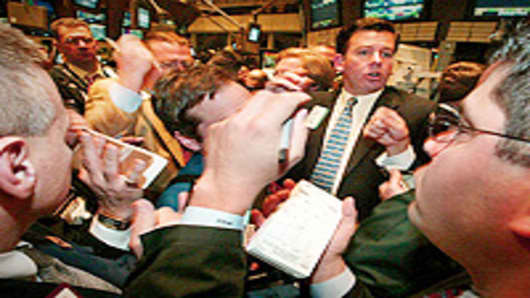Even as the stock market keeps climbing higher, there's no shortage of aggressive bets that the rally won't last.
Exchange-traded funds that bet against further gains, in fact, have been hugely popular with investors, making the group the fastest-growing fund class in the $1.1 trillion ETF industry.
The so-called "inverse" ETFs, which can sometimes pay double or triple the opposite move of the benchmarks they track, have seen a 16 percent growth in assets this year, against 4 percent for the industry as a whole.
Investors like the inverse funds because, when used properly, they provide effective hedges against drops in the market. The funds are best used over the short term—generally a few days at most—because of their volatility. They can be a dangerous buy-and-hold instrument.
With the growth of the class, it's a sure sign that there's plenty of sentiment that the market, despite its meteoric climb over the past two-plus years, has yet to garner full confidence that it won't collapse again.
"Traders do seem to be increasingly worried that the lot labeled 'US stocks' may be ready for a mass exodus, as money flows into ETF volatility plays and inverse hedges are solidly higher in the recent week and month," Nick Colas, chief market strategist at ConvergEx in New York, wrote in a note to clients Tuesday.
The Standard & Poor's 500 is up more than 6 percent in 2011 and has risen incrementally since first-quarter earnings reports have begun filing in.
However, the April 18 downgrade from S&P of its outlook for US debtprovided a stark reminder that for all the health of corporate balance sheets, the nation's economy still faces the specter of fiscal instability.
Combine that with swelling food and energy prices and global turmoil, and it makes for tremendous uncertainty.
As such, investors continue to hold back on a full commitment to stocks.
"The average US consumer is still worried about the future," says Kathy Boyle, president of Chapin Hill Advisors in New York. "When you think about the big picture, Wall Street can discount all these things and the market can push up and anticipate forward. But the average guy on the street is still feeling very blue about the overall economy and the world."
During the worst of the financial crisis in 2008 and 2009, Boyle used the inverse ETFs to keep an edge on a rapidly declining stock market and an economic outlook that seemed to portend disaster at every turn.
Now, however, she worries that investors who believe another quasi-armageddon is at hand are buying and holding the leveraged ETFs—almost never a good idea—and are getting crushed as a stock rally underpinned by Federal Reserve liquidity presses on.
"The way these things work is you get big pops when these unexpected things happen," Boyle says. "Most people can't anticipate when S&P is going to downgrade the US debt. But these unexpected Black Swans are part of everybody's vocabulary and everybody's anticipating them."
Indeed, ETFs such as the ProShares Ultra Short S&P 500 will show big gains on days like the S&P downgrade and during events such as the tsunami in Japan.
But when the turmoil subsides and the market resumes its way higher, the fund and others like it will get hammered. The S&P 500 double-inverse ETF has lost 13.6 percent in 2011, by extension doubling the loss of the index.
That's what makes holding the inverse funds so problematic. As such, they should be used as trading vehicles in anticipation of a visible market trouble spot, Boyle says.
"They're extremely volatile but if you hit it you can make a lot of money," she says.
Interestingly, the most popular inverse ETF bets against the bond market—a de facto bet for the stock market. Still, that fund, the UltraShort Barclays 20+ Year Treasury, with its $6.3 billion market cap, is down 5 percent in 2011. The fund bets against the long end of the Treasury curveand is a double inverse as well.
So while ETF movement shows that investor uncertainty remains high, it also is a demonstration that trying to get too far ahead of the risk curve can present its own kind of danger.
"First and foremost there are no shortage of reasons to worry. But by orders of magnitude economic growth is most important," says Gary Flam, portfolio manager at Bel Air Investment Advisors in Los Angeles and a stock bull who believes investor worry is at an unnecessary extreme.
"These headwinds take on more importance when economic growth slows," he adds. "The rub is trying to figure out when economic growth slows. From that standpoint, it's a difficult thing."
- Jeff Cox is co-author, with Peter J. Tanous, of the just-released Debt, Deficits and the Demise of the American Economy (Wiley).




